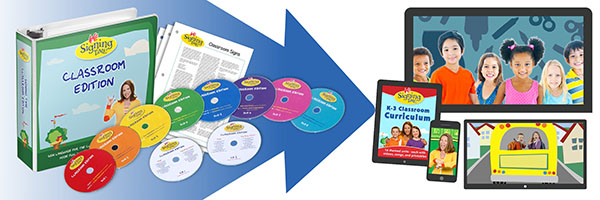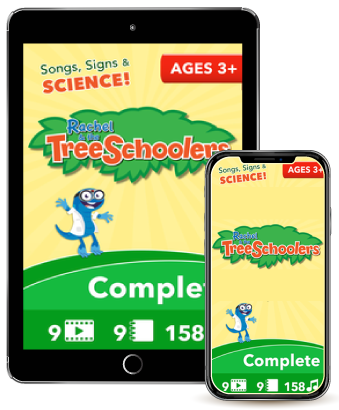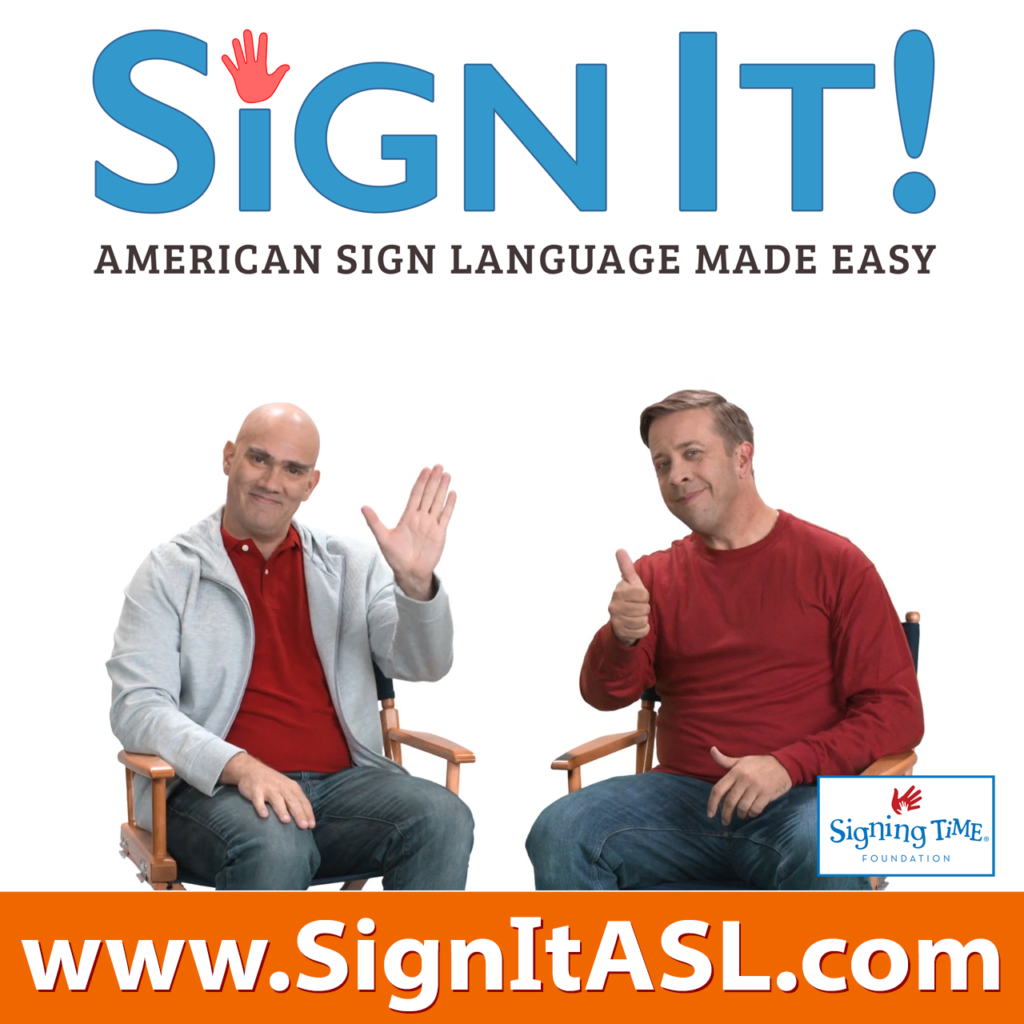Sign Language Curriculum for Teachers and Homeschoolers

Why use sign language in the classroom?
- American Sign Language is a second language.
- Teaching ASL helps students become more engaged in learning.
- Signing is a powerful tool for behavior management in the classroom. It allows silent cues to communicate with students.
- Reinforces other classroom curriculum.
Why Signing Time?
Signing Time is the only early learning system to combine the power of music and sign language to create exceptional learning experiences for children from birth through elementary school. Research shows that signing in the classroom can build vocabulary and enhance social interaction for students of all abilities.
Teacher-to-Teacher
I teach in a special needs classroom. We incorporate Signing Time into our daily routine. I love Signing Time because it not only helps with communication, but also introduces vocabulary and sight words. My students absolutely love the videos and do not even realize that they are learning while they watch. Thank you so much for these wonderful videos.
Lisa H.
Louisville, KY
July 12, 2014
Teach American Sign Language using fun-filled lessons & engaging activities to infants, toddlers, and preschoolers.
What sign language curriculum is available for child care centers and preschools?
The Baby Signing Time Preschool and Childcare Program is based on the award-winning Baby Sign Language System, Baby Signing Time, and contains fun-filled lessons and activities for infants, toddlers, and pre-schoolers, plus teacher guides and more. Signing with young children will help you be a more effective teacher – and bring an element of fun to your daily routines and lesson plans.
Signs allow children to:
- tell you what they want – without getting frustrated
- let you know if they are hurt or sick
- express their feelings
- learn to get along with others
When signs are used in your infant and toddler program, or preschool center, there are fewer incidents of tantrums, hitting, biting, and other types of aggression. In addition to creating more peaceful learning environments, signing helps you address the learning styles of all the children in your care. When signs and words are used together, auditory learners hear the word, visual learners see the sign, and kinesthetic learners can use their hands to make the sign.
Research shows that infants and toddlers who use signs learn to talk sooner. They have larger vocabularies and use longer sentences when they start talking. And they feel more secure and confident. In addition, studies have found that preschool children who were taught signs as a part of their reading instruction scored higher on standardized reading tests.
We offer individual lessons and also site licenses which include accounts for each student so the children can watch and practice at home.
What sign language curriculum is available for elementary classrooms?
Signing Time K-3 Classroom Curriculum brings American Sign Language (ASL) into the classroom. The 16 themed units include lesson plans, printables, songs, and videos teachers can use as stand alone material or work into their daily routines throughout the day. Students learn ASL vocabulary through physical movement, fun games, catchy songs, and other activities. Our new digital format provides options for both teacher and individual student accounts.
Signing can help students become more engaged in learning in all subject areas. With fun visual, kinesthetic, and auditory components, sign language activates a multi-sensory learning experience. Studies show that when words are presented orally, visually, and kinesthetically (through sign language), students’ scores on vocabulary tests are significantly higher than their non-signing peers.
Signing is a powerful tool for behavior management in the classroom. Sign language requires eye contact, which automatically helps draw students’ attention to the teacher. When teachers use signs to cue transitions and new activities, students will be prepared to look and listen for new directions. Signing with students while they line up helps them stay actively engaged – and quiet – as they move through the hallways. Teachers who sign in their classrooms report that signing helps create a more harmonious environment.
We offer individual lessons and also site licenses which include accounts for each student so the teacher can assign lessons for the children to watch and practice at home.

What sign language curriculums are available for homeschool?
One of the biggest challenges that homeschooling parents face is finding teaching resources that will meet their child’s learning needs and effectively address those needs over time. Teaching American Sign Language gives your child(ren) the building blocks of a second language. Signing meets the needs of visual, auditory, and kinesthetic/tactile learners. Signing Time resources provide a rich, multi-sensory experience to target a wide range of learning styles and preferences.
Signing Time has a complete library of educational materials, including videos, downloadable songs, flash cards, board books, activity guides. These diverse resources give you a wide range of teaching options, so you can present material in the way that works best for you.
Use Rachel & the TreeSchoolers science curriculum to teach the Scientific Reasoning method with songs and sign language. This series teaches kids about seasons and weather, plants and photosynthesis, animals and habitats, health and safety, earth science, and much, much more! FREE Activity Guides for each episode to reinforce what you are studying. Rachel & the TreeSchoolers is available on MySigningTime.com. Request Guides Now
How do I use signs to teach science?
Signing supports visual, auditory, AND kinesthetic learning. Rachel & the TreeSchoolers incorporates the best elements of Schoolhouse Rock, Mr. Rogers and Sesame Street to deliver a well-rounded preschool science curriculum for ages 2-6. Teach SCIENCE with songs and sign language. Rachel & the TreeSchoolers introduces foundational science concepts in a way your students will never forget. This series teaches kids about seasons and weather, plants and photosynthesis, animals and habitats, health and safety, earth science, and much, much more!
This Science Learning System:
- This Science Learning System: CORI 4-Step Learning Cycle lets your child go to preschool with Rachel from Signing Time!
- actively engages children in learning
- teaches values like kindness, teamwork and sharing
What sign language curriculum do I use with older children?
Sign It ASL is ideal for kids 8+, teenagers, and adults who want a fun way to learn ASL online. The lessons use skits and comedy to teach vocabulary, fingerspelling, phrases, sentences, grammar, non-manual signals, Deaf culture, and much more. This course features many ASL professionals including the stars of Signing Time (Alex, Leah and Rachel Coleman), ASL comedian Keith Wann, and numerous well-known Deaf actors and educators (including Peter Cook, Crom Saunders, Alexandria Wailes, Maleni Chaitoo, Sean Forbes, Manny Hernandez, Patrick Fischer, Justin Callaway, and Ben Jarashow). This course is now used in many homeschools, public high schools, and some colleges as a major component of the ASL curriculum.
Sign It ASL Includes:
- fun chapter videos with voice on/off feature
- fingerspelling, vocabulary, and grammar practice
- graded quizzes and exams
- progress tracking
- receptive conversation practice
- comprehensive ASL dictionary
- certificates of completion
Still have questions? Find out more in our Sign It ASL FAQ.






